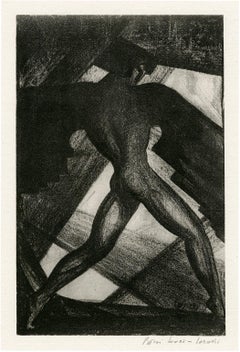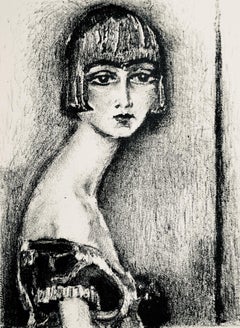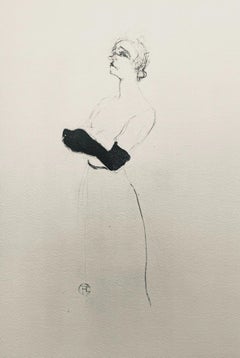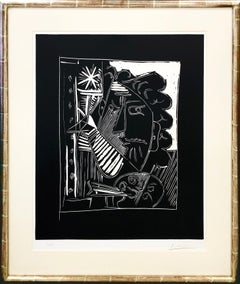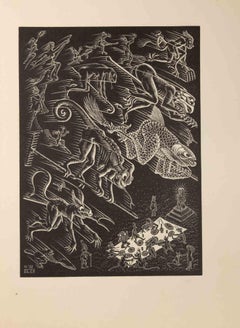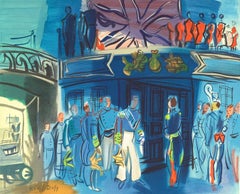People Figurative Prints
to
4,729
15,081
4,828
4,213
1,793
1,037
Overall Width
to
Overall Height
to
9,989
4,417
1,630
1,412
953
768
717
504
285
219
180
58
32
7
666
272
252
228
219
2,200
5,242
16,159
3,443
239
519
1,163
937
882
1,516
1,995
3,107
1,497
690
1,804
17,696
8,451
778
27,047
14,823
10,868
9,104
7,885
7,003
4,661
4,218
2,456
2,060
1,933
1,848
1,623
1,459
1,434
1,428
1,406
1,282
1,228
1,107
10,786
8,059
3,624
2,012
1,607
2,434
12,930
11,818
10,652
Art Subject: People
Untitled (Nike)
Located in Myrtle Beach, SC
Boris Lovet-Lorski, Untitled (Nike), lithograph, edition 250, 1929. Signed and numbered 1 in pencil. Number 1 of Volume 1, a series of 10 lithographs in each of 2 portfolios, publish...
Category
1920s Art Deco Figurative Prints
Materials
Lithograph
La Perruque d'argent (Juffermans 6), Van Dongen, Kees van Dongen
Located in Southampton, NY
Lithograph on vélin paper. Unsigned and unnumbered, as issued. Good condition. Notes: From the album, Van Dongen, 1925. Published by Henri Floury, Paris; printed by Pierre Dumont, Pa...
Category
1920s Modern Figurative Prints
Materials
Lithograph
$3,596 Sale Price
20% Off
Toulouse-Lautrec, Composition, Yvette Guilbert vue par Toulouse-Lautrec (after)
Located in Southampton, NY
Lithograph and stencil on vélin Rives BFK paper. Unsigned and unnumbered, as issued. Good Condition; never framed or matted. Notes: From the folio, Yvette Guilbert vue par Toulouse-...
Category
1950s Post-Impressionist Figurative Prints
Materials
Lithograph, Stencil
$716 Sale Price
20% Off
LE PEINTRE A LA PALETTE (BLOCH 1153)
Located in Aventura, FL
Linocut on Arches wove paper. Hand signed and numbered by the artist in pencil. Image size 25 x 20.75 inches. Sheet size 29.6 x 24.5 inches. Frame size approx 34.5 x 29.5 inches. Pri...
Category
1960s Cubist Animal Prints
Materials
Paper, Linocut
$31,600 Sale Price
46% Off
Flying Demons - Woodcut by Maurits Cornelis Escher - 1932
Located in Roma, IT
Woodcut print from the Series "Der vreeselijke avonturen vas Scholastica" (The Terrible Adventures of Scholastica).
Edition of 300, published by A. J. van Dishoeck.
Unsigned, ass i...
Category
1930s Modern Figurative Prints
Materials
Woodcut
Dufy, Réception d'un amiral anglais, Raoul Dufy, Collection Pierre Lévy (after)
By Raoul Dufy
Located in Fairfield, CT
Medium: Lithograph on vélin d'Arches paper
Year: 1969
Paper Size: 20 x 26 inches
Inscription: Signed in the plate and unnumbered, as issued
Notes: From the folio, Raoul Dufy, IV, Col...
Category
1960s Modern Landscape Prints
Materials
Lithograph
$796 Sale Price
20% Off
AUTUMN OF THE ROOSTER Signed Lithograph, Black Couple, African American Culture
Located in Union City, NJ
AUTUMN OF THE ROOSTER is an original hand drawn, limited edition lithograph by the American master artist and collagist Romare Bearden printed usi...
Category
1980s Contemporary Figurative Prints
Materials
Lithograph
Gold Tiara Round Crown
Located in Palm Springs, CA
Signed, titled, and numbered from the edition of 15. Image of a young girl with a crown and brooch. While the images have some resemblance to traditional Japanese Ukiyo-e prints, the...
Category
2010s Contemporary Figurative Prints
Materials
Etching, Aquatint
Matisse, Quelle soie aux baumes de temps, Poésies (after)
Located in Fairfield, CT
Medium: Lithograph on papier bouffant des Papeteries de Casteljoux paper
Year: 1970
Paper Size: 11.24 x 8.46 inches
Inscription: Unsigned and unnumbered, as issued
Notes: From the fo...
Category
1970s Modern Landscape Prints
Materials
Lithograph
$716 Sale Price
20% Off
NO. 7
Located in New York, NY
The photographs of the young Turkish artist Melissa Mizrakli focus on the human body, giving it a personal interpretation. In some of her black and white works she uses the human body only as a pictorial sign in order to create almost abstract works. First made anonymous, the female model is then cloned and circularly multiplied. The result is a kind of wheel in which the repeated human body gives birth to a new, seemingly vegetal or mineral structure. Thus, the human element seems to be transformed into different other natural species...
Category
2010s Contemporary Black and White Photography
Materials
Photographic Paper, Plexiglass, Archival Paper, Archival Pigment
Raymond Pettibon Black Flag flyer 1982 (Raymond Pettibon punk flyer)
Located in NEW YORK, NY
Raymond Pettibon Black Flag flyer Los Angeles, 1982:
Black Flag Olympic Auditorium, Los Angles, CA, Saturday July 17, 1982. Flyer/handbill for gig by Black Flag, DOA, Descendents, U...
Category
1980s Pop Art Prints and Multiples
Materials
Offset
Banging the Drum, Offset Print by Yoshitomo Nara
Located in Hong Kong, HK
Banging the Drum, 2020 by Yoshitomo Nara
Offset lithograph in colors, 2020,
on 80# Archival Quality Wove Paper, unframed
published by Dallas Contempo...
Category
2010s Contemporary Figurative Prints
Materials
Offset
Chagall, Composition (Cramer 36; Mourlot 208), Derrière le Miroir (after)
By Marc Chagall
Located in Southampton, NY
Lithograph on vélin paper. Inscription: Unsigned and unnumbered. Good condition, with centerfold, as issued. Notes: From Derrière le miroir, N° 107-109. Published by Aimé Maeght, Édi...
Category
1950s Expressionist Figurative Prints
Materials
Lithograph
$1,516 Sale Price
20% Off
Down the River
Located in London, GB
In this sentimental work from 1939, Benton expresses his admiration for the rural lifestyle of the Midwest. He highlights the connection between man and the land by depicting two fig...
Category
1930s American Modern Figurative Prints
Materials
Lithograph
Profile of an African Woman —1920s Modernism
Located in Myrtle Beach, SC
Boris Lovet-Lorski, Untitled (Profile of an African Woman), lithograph, edition 250, 1929. Signed and numbered 15 in pencil. Number 15 of Volume 2, a series of 10 lithographs publish...
Category
1920s American Modern Figurative Prints
Materials
Lithograph
$760 Sale Price
20% Off
The Mythology The Milky Way
Located in Hollywood, FL
ARTIST: Salvador Dali
TITLE: The Mythology The Milky Way
MEDIUM: Etching
SIGNED: Hand Signed
PUBLISHER: Editions Argillet, Paris
EDITION NUMBER: 30/150
MEASUREMENTS: 22" x 30"...
Category
1960s Surrealist Figurative Prints
Materials
Etching
Taira no Munekiyo Captures -Woodcut Print by Utagawa Hirosada - 1856
Located in Roma, IT
Taira no Munekiyo Captures Tokiwa no Mae is an original modern artwork realized by Utagawa Hirosada (Japanese, active 1825–75) in 1856.
Woodcut print oban format. Signature Ichiyosa...
Category
19th Century Modern Figurative Prints
Materials
Woodcut
The Sleeping Woman La dormeuse - Sleeping Women Portrait French Spanish
Located in London, GB
This lithograph is hand signed in blue pencil by the artist "Picasso" at the lower left image. Edition info 11/50.
It is also hand numbered in blue pencil from the edition of 50, at ...
Category
1940s Figurative Prints
Materials
Lithograph
A Rural Genji - Woodcut by Utagawa Kunisada - 1829-1842
Located in Roma, IT
A rural Genji is an original artwork realized in 1829-1842 by Utagawa Kunisada (1786-1865).
Illustrated book in two volumes. Book title "Nise Murasaki Inaka Jenji", 9th instalment....
Category
19th Century Modern Figurative Prints
Materials
Woodcut
after Henri Matisse - Sleeping Blue Nude - Lithograph
Located in Collonge Bellerive, Geneve, CH
after Henri MATISSE
Edition of 200
with the printed signature, as issued
76 x 56 cm
With stamp of the Succession Matisse
References : Artvalue - Succession Matisse
Category
1950s Modern Nude Prints
Materials
Lithograph
Sophie aux bas rouges, 1993, original lithograph by Jean Jansem
By Jean Jansem
Located in Les Acacias GE, GE
Jean Jansem (1920-2013)
Sophie aux bas rouges, 1993
Lithographie sur papier Arches, justifiée E/A
Signée en bas à droite
66 x 50 cm / 76 x 56 cm
Bibliographie:
CR Jansem, 2000, n°...
Category
Late 20th Century Expressionist Figurative Prints
Materials
Lithograph
$847 Sale Price
24% Off
Paris, La Seine
Located in San Francisco, CA
This artwork titled " Paris, Place De La Concorde" c.1980, is an original colors lithograph on Arches paper by French artist Urbain Huchet, 1930-2014. It is hand signed and numbered ...
Category
Late 20th Century Impressionist Figurative Prints
Materials
Lithograph
William Hamilton Classical Greek Vase-Painting Engraving
Located in Melbourne, Victoria
Subject : Ancient Greek vase-painting from depicting a departure scene with a young warrior between two women.
Technique : Copper-line engraving with original hand-colouring
Back...
Category
Early 1800s Other Art Style Figurative Prints
Materials
Engraving
Matisse, Fusain, Dessins de Henri-Matisse (after)
Located in Southampton, NY
Lithograph on vélin Lafuma paper. Unsigned and unnumbered, as issued. Good Condition; never framed or matted. Notes: From the volume, Dessins de Henri-Matisse, 1925. Published by Édi...
Category
1920s Modern Landscape Prints
Materials
Lithograph
$956 Sale Price
20% Off
Original George Petty Pinup 'woman sitting with sunhat and phone
Located in Spokane, WA
Original George Petty pinup, woman sitting with big sunhat and telephone. Archivally linen backed vintage pinup in very fine condition, ready to frame. (Note: this lithograph is NOT removed from a pinup calendar!)
Introducing the original George Petty pinup, a captivating piece of art that showcases the iconic style and exquisite talent of George Petty himself. This artwork features a stunning woman adorned with a large red outlined sun hat, donning a classic one-piece bathing suit and high heels. The addition of a telephone in her right hand adds an intriguing element, making this pinup a unique and visually striking piece. The attention to detail and expert craftsmanship are evident in every brushstroke, bringing the woman to life and capturing the essence of Petty's artistic mastery. As an original George Petty pinup, this artwork holds historical and artistic value, making it a collectible and valuable addition to any art enthusiast's repertoire.
About Petty:
George Petty was an American pin-up artist from the 1920s to the 1970s. His pin-up art appeared primarily in Esquire and True magazine, but was also in calendars marketed by Esquire, True and Ridgid Tool Company. Petty's Esquire gatefolds originated and popularized the magazine device of centerfold spreads. Reproductions of his work were widely rendered by military artists as nose art decorating warplanes during the Second World War, including the Memphis Belle...
Category
1940s American Realist Portrait Prints
Materials
Lithograph
Cypriano (A Basque Boy)
Located in Middletown, NY
Etching on cream wove paper. 6 5/16 x 3 3/4 inches (159 x 94 mm), full margin. Signed in pencil lower center margin, from the edition of 111. A well inked impression with a minor cre...
Category
Mid-20th Century American Modern Portrait Prints
Materials
Handmade Paper, Etching
Ordinis Benedictini monialis; Saint Thecla of Kitzengen
Located in Middletown, NY
King, Daniel (with Wenceslaus Hollar)
Ordinis Benedictini monialis; Saint Thecla of Kitzengen
c 1650.
Etching with engraving on cream laid paper with an indiscernible watermark wit...
Category
Mid-19th Century Old Masters Portrait Prints
Materials
Etching, Laid Paper, Engraving
Spring, Art Nouveau Giclee Print after Louis Icart
By Louis Icart
Located in Long Island City, NY
Louis Icart, After, French (1888 - 1950) - Spring, Year: circa 1990, Medium: Giclee Print, numbered in pencil, Edition: 57/500, Size: 10 x 7.5 in. (25.4 x 19.05 cm), Frame Size: ...
Category
1990s Art Nouveau Figurative Prints
Materials
Giclée
Renoir, Claude Renoir écrivant, Les Lithographies de Renoir (after)
Located in Fairfield, CT
Medium: Lithograph on grand vélin Renage filigrané à la marque de l'éditeur paper.
Year: 1951
Paper Size: 12.5 x 9.5 inches; image size: 6.69 x 8.66 inches
Inscription: Unsigned and ...
Category
1950s Impressionist Figurative Prints
Materials
Lithograph
$716 Sale Price
20% Off
The Negro Speaks of Rivers, Sunrise Is Coming After While
Located in Southampton, NY
Silkscreen on vélin d’Arches paper. Paper Size: 14 x 11 inches. Inscription: Unsigned and unnumbered, as issued. Notes: From the folio, Bookmarks in the Pages of Life, 1998. Published by The Limited Editions Club, New York; printed by Drexel Press, Inc. Long Island City, 1998. Excerpted from the folio, CCC examples, designed, hand-set in Monotype Perpetua, printed, and hand-bound by Michael and Winifred Bixler, Skaneateles, New York. Paper made in France at Arches. Silkscreens printed by the Drexel Press, Inc. Long Island City, New York.
PHOEBE BEASLEY...
Category
1990s Expressionist Figurative Prints
Materials
Screen
$4,796 Sale Price
20% Off
John Lennon (orange version)
Located in Palm Springs, CA
Title: John Lennon
Artist: John Van Hamersveld
Medium: Color SERIGRAPH
Substrate: COVENTRY RAG 320 GSM
Paper Size: 34.25″ x 44”
Image Size: 30” x 40”
Signed and Numbered Edition Printers Proof
Year: 2007
John Van Hamersveld (born September 1, 1941) is an American graphic artist and illustrator who designed record jackets for pop and psychedelic bands from the 1960s onward. Among the 300 albums[3] are the covers of Magical Mystery...
Category
Early 2000s Contemporary Portrait Prints
Materials
Screen
Matador - Lithograph by José Guevara - 1971
Located in Roma, IT
Matador is an original artwork realized by Josè Guevara in 1971 .
Colored lithograph on paper. Edited by Fondazione Di Paolo.
Hand-signed in pencil on t...
Category
1970s Contemporary Figurative Prints
Materials
Lithograph
POP SHOP QUAD III
By Keith Haring
Located in Aventura, FL
Screenprint in colors, on wove paper. Stamped with the artist's estate and signed, dated and numbered by the executor, Julia Gruen, in pencil on the rever...
Category
1980s Pop Art Figurative Prints
Materials
Paper, Screen
Seated Dancer, from: Ten Dancers - French Ballet Dancer
Located in London, GB
This original lithograph is signed in pencil by the artist “Henri Matisse.” at the lower right margin.
The work is also hand numbered 87 in pencil from the edition of 130, above the ...
Category
1920s Modern Figurative Prints
Materials
Lithograph
La Folie des Grandeurs II -20th Century, Surrealist, Lithogr, Figurative Print
Located in Sint-Truiden, BE
Color lithograph after the 1948 oil on canvas by René Magritte, printed signature of Magritte and numbered from the edition of 300.
The lithograph features the dry stamps of the Mag...
Category
20th Century Surrealist Figurative Prints
Materials
Lithograph
PICASSO TOREROS
Located in Palm Springs, CA
Pablo Picasso – Toros y Toreros (First American Edition, 1961)
Publisher: George Braziller, New York
Format: Hardcover, no slipcase
Includes: Four original lithographs printed by Mou...
Category
1960s Animal Prints
Materials
Lithograph
"Casual Dinning" From the suite "Memories Retrospective"
Located in San Francisco, CA
This artwork titled "Casual Dinning" from the suite "Memories Retrospective" c.1990 is an original color serigraph on paper by Israeli artist Itzchac Tarkay 1935-2012. It is hand si...
Category
Late 20th Century Art Deco Figurative Prints
Materials
Screen
Les Champs-Élysées, Place de la Concorde, A La gloire à Paris, Raoul Dufy
By Raoul Dufy
Located in Southampton, NY
Etching on vélin Canson et Montgolfier paper. Unsigned and unnumbered, as issued. Good condition. Published by L'Imprimerie Daragnès, Paris; printed by Jean Gabriel Daragnès, Paris, ...
Category
1930s Modern Landscape Prints
Materials
Etching
$1,436 Sale Price
20% Off
'Priests' from 'In Praise of Folly' — Mid-Century Graphic Modernism
By Lynd Ward
Located in Myrtle Beach, SC
Lynd Ward, 'Priests' from the series 'Moriae Encomium (The Praise of Folly)', mezzotint, 1943, no edition, proofs only. Signed in pencil. A superb, richly-inked impression, on cream wove paper; the full sheet with margins (1 1/4 to 2 inches) in excellent condition. Matted to museum standards, unframed. Scarce.
Image size 7 3/4 x 4 3/4 inches (197 x 121 mm); sheet size 10 11/16 x 8 1/16 inches (271 x 204 mm).
Created by the artist for 'Erasmus's Moriae Encomium,' or 'In Praise of Folly,' published by the Limited Editions Club, 1943. A rare, signed, proof impression apart from the Limited Editions Club publication.
ABOUT THE ARTIST
Lynd Ward is acknowledged as one of America’s foremost wood engravers and book illustrators of the first half of the twentieth century. His innovative use of narrative printmaking as a stand-alone storytelling vehicle was uniquely successful in reaching a broad audience. The powerful psychological intensity of his work, celebrated for its dynamic design, technical precision, and compelling dramatic content, finds resonance in the literature of Poe, Melville, and Hawthorne. Like these classic American writers, Ward was concerned with the themes of man’s inner struggles and the role of the subconscious in determining his destiny. An artist of social conscience during the Great Depression and World War II, he infused his graphic images with his unique brand of social realism, deftly portraying the problems that challenged the ideals of American society.
The son of a Methodist preacher, Lynd Ward, moved from Chicago to Massachusetts at an early age. He graduated from the Teachers College of Columbia University, New York, in 1926, where he studied illustration and graphic arts. He married May Yonge McNeer in 1936 and left for Europe for their honeymoon in Eastern Europe. After four months, they settled in Leipzig, where Ward studied at the National Academy of Graphic Arts and Bookmaking. Inspired by Belgian expressionist artist Frans Masereel's graphic novel ‘The Sun,’ and another graphic novel by the German artist Otto Nückel, ‘Destiny,’ he determined to create his own "wordless" novel. Upon his return to America, Ward completed his first book, ‘God's Man: A Novel in Woodcuts,’ published in 1929. ‘Gods’ Man’ was a great success for its author and publisher and was reprinted four times in 1930, including a British edition. This book and several which followed it, ‘Madman’s Drum,’ 1930, ‘Wild Pilgrimage,’ 1932, ‘Prelude to a Million Years,’ 1933, ‘Song Without Words,' 1936, ‘Vertigo,’ 1937; and ‘Last Unfinished Wordless Novel’ (created in the 1960s and published in 2001) were comprised solely of Ward's wood engravings. Ward designed each graphic image to occupy an entire page, the sequence of which conveys the story's narrative.
In 1937, Ward was named Director of the Graphic Arts Division of the Federal Art Project, a division of the Works Progress Administration (WPA). In the following years, Ward went on to illustrate more than one hundred books (some of which he wrote), including classics for the Limited Editions Club Goethe’s ‘Faust,’ Faulkner’s ‘A Green Bough,’ and Mary Shelley’s ‘Frankenstein,’ and several children’s books. He also produced single-subject wood engravings, paintings, and drawings. His print ‘Sanctuary,’ 1939, was shown at the 1939 New York World’s Fair, and ‘Clouded Over,’ 1948, received the 1948 Library of Congress Award and was included in ‘American Prize Prints of the 20th Century’ by Albert Reese. He received the National Academy of Design Print Award (1949), the New York Times Best Illustrated Award (1973), and the Regina Award (Catholic Library Association, 1975). ‘The Biggest Bear,’ a children’s book with illustrations by Ward, was the recipient of the esteemed 1952 Caldecott Medal of the American Library Association.
An Honorary Fellow of the Royal Society of Painter-Etchers and Engravers, Ward was a member and board member of the National Academy of Design and the Artists’ League of America. He served several terms as president of the Society of American Graphic Artists and was a member of the American Artists Congress and the Society of Illustrators. Ward exhibited at the American Artists Congress; the National Academy of Design; the John Herron Art Institute; and the Library of Congress. He had a one-person show at Associated American Artists, NY, on the publication of his monograph 'Storyteller Without Words,' 1974; AAA mounted a memorial exhibition in 1986. The May 1976 issue of 'Bibliognost,' a book collector’s publication, was dedicated to Ward. ‘Lynd Ward, His Bookplate Designs,’ an article by Dan Burne Jones, was published in the American Society of Bookplate Collectors and Designers Yearbook, 1981/82.
In 2001, sixteen years after his death, Rutgers University Libraries published ’Lynd Ward’s Last Unfinished Wordless Novel.’ The blocks were intended to be part of a novel in woodcuts, the first since Vertigo, but Ward did not live to complete the project. Master printer and book designer Barbara Henry collated and printed the twenty-six finished blocks out of the forty-four initially planned for the still unnamed narrative.
In 2010 the Library of America honored Ward’s achievements with the meticulous production of a collection of Ward’s woodcut novels—the first time the Library had gone wordless. The publication replicated his original editions with a single full-size image printed on the right page of each double-page spread. In his introduction to the books, renowned cartoonist/illustrator Art...
Category
1940s American Modern Figurative Prints
Materials
Mezzotint
Al Dolo - Etching by Giovanni Antonio Canal - 1735/44
By Giovanni Antonio Canal (Canaletto)
Located in Roma, IT
Al Dolo is an original Artwork realized by Giovanni Antonio Canal, commonly known as Canaletto (Venice, 1697 - 1768).
Original Etching on Laid paper...
Category
1730s Modern Figurative Prints
Materials
Etching
Original Tennis Club Bray Dunes - French vintage sports poster
Located in Spokane, WA
Original vintage poster. Tennis Club Bray Dunes
Mounted on acid-free archival linen.
Condition: Grade A- with 1/16" left top edge wear.
Clos Fleuri
Tel: 47
2 Courts couverts (2 c...
Category
1960s Art Deco Figurative Prints
Materials
Lithograph
$460 Sale Price
20% Off
'A Visit to the King of the Waters' — Graphic Modernism
Located in Myrtle Beach, SC
Fritz Eichenberg, 'A Visit to the King of the Waters' from the suite 'The Adventurous Simplicissimus', wood engraving, 1977, artist's proof apart from the edition of 50. Signed in pencil. Signed in the block, lower right. A fine, richly-inked impression, on cream wove paper, with full margins (1 1/2 to 2 inches), in excellent condition. Image size 14 x 12 inches (356 x 305 mm); sheet size 17 1/2 x 15 inches (445 x 381 mm). Archivally sleeved, unmatted.
ABOUT THIS WORK
'Simplicius Simplicissimus' (German: Der abenteuerliche Simplicissimus Teutsch) is a picaresque novel of the lower Baroque style, written in five books by Hans Jakob Christoffel von Grimmelshausen published in 1668, with the sequel Continuatio appearing in 1669.
The novel is told from the perspective of its protagonist Simplicius, a rogue or picaro typical of the picaresque novel, as he traverses the tumultuous world of the Holy Roman Empire during the Thirty Years' War. Raised by a peasant family, he is separated from his home by foraging dragoons. He is adopted by a hermit living in the forest, who teaches him to read and introduces him to religion. The hermit also gives Simplicius his name because he is so simple that he does not know his own name. After the death of the hermit, Simplicius must fend for himself. He is conscripted at a young age into service and, from there, embarks on years of foraging, military triumph, wealth, prostitution, disease, bourgeois domestic life, and travels to Russia, France, and an alternate world inhabited by mermen. The novel ends with Simplicius turning to a life of hermitage, denouncing the world as corrupt.
ABOUT THE ARTIST
Fritz Eichenberg (1901–1990) was a German-American illustrator and arts educator who worked primarily in wood engraving. His best-known works were concerned with religion, social justice, and nonviolence.
Eichenberg was born to a Jewish family in Cologne, Germany, where the destruction of World War I helped to shape his anti-war sentiments. He worked as a printer's apprentice and studied at the Municipal School of Applied Arts in Cologne and the Academy of Graphic Arts in Leipzig, where he studied under Hugo Steiner-Prag. In 1923 he moved to Berlin to begin his career as an artist, producing illustrations for books and newspapers. In his newspaper and magazine work, Eichenberg was politically outspoken and sometimes wrote and illustrated his reporting.
In 1933, the rise of Adolf Hitler drove Eichenberg, who was a public critic of the Nazis, to emigrate with his wife and children to the United States. He settled in New York City, where he lived most of his life. He worked in the WPA Federal Arts Project and was a member of the Society of American Graphic Artists.
In his prolific career as a book illustrator, Eichenberg portrayed many forms of literature but specialized in works with elements of extreme spiritual and emotional conflict, fantasy, or social satire. Over his long career, Eichenberg was commissioned to illustrate more than 100 classics by publishers in the United States and abroad, including works by renowned authors Dostoyevsky, Tolstoy, Charlotte and Emily Brontë, Poe, Swift, and Grimmelshausen. He also wrote and illustrated books of folklore and children's stories.
Eichenberg was a long-time contributor to the progressive magazine The Nation, his illustrations appearing between 1930 and 1980. Eichenberg’s work has been featured by such esteemed publishers as The Heritage Club, Random House, Book of the Month Club, The Limited Editions Club, Kingsport Press, Aquarius Press, and Doubleday.
Raised in a non-religious family, Eichenberg had been attracted to Taoism as a child. Following his wife's unexpected death in 1937, he turned briefly to Zen Buddhist meditation, then joined the Religious Society of Friends in 1940. Though he remained a Quaker until his death, Eichenberg was also associated with Catholic charity work through his friendship with Dorothy Day...
Category
1970s American Modern Figurative Prints
Materials
Woodcut
Dufy, Composition, Les Côtes Normandes (after)
By Raoul Dufy
Located in Southampton, NY
Lithograph on grand vélin d'Arches spécial paper. Unsigned and unnumbered, as issued. Good condition. Notes: From the folio, Les Côtes Normandes 1961. Published by Pierre de Tartas, ...
Category
1960s Modern Landscape Prints
Materials
Lithograph
$1,516 Sale Price
20% Off
Cocteau, Composition, Taureaux (after)
By Jean Cocteau
Located in Southampton, NY
Lithograph on vélin d'Arches paper. Inscription: signed in the plate and unnumbered, as issued. Good condition. Notes: from the folio, Taureaux, Lithographies de Jean Cocteau, 1965. ...
Category
1960s Modern Figurative Prints
Materials
Lithograph
$716 Sale Price
20% Off
Wheelbarrow Race
Located in Storrs, CT
1925-26. Drypoint. Appleby 114. 8 9/16 x 12 (sheet 12 x 17). Edition 100, #10. An excellent impression with burr, printed with plate tone on the full sheet of 'VGI' laid paper with ...
Category
1920s Modern Figurative Prints
Materials
Drypoint, Etching
Life in the Sea : Mermaid Maternity - Original wooodcut, Handsigned & Numbered
Located in Paris, IDF
Henri AMEDEE-WETTER (1869-1929)
Life in the Sea : Mermaid Maternity, 1922
Original woodcut
Handsigned in pencil
Numbered /105
On vellum 32.5 x 25.5 cm (c. 13 x 10 in)
Bears the blin...
Category
1920s Modern Figurative Prints
Materials
Woodcut
"Lead Us Not Into Temptation" Original 1899 Color Lithograph by Alphonse Mucha
Located in Chicago, IL
Alphonse Mucha worked mainly as a poster artist and became an influential figure of Art Nouveau in late 1890s, when poster illustrations were emerging as popular art form and new pri...
Category
1890s Art Nouveau Figurative Prints
Materials
Lithograph
Ruins of a Mosque, Tlemciem, Algeria
Located in Middletown, NY
New York: New York Etching Club, 1887.
Etching with aquatint in brown ink on cream laid paper, 4 x 5 inches (98 x 125 mm), full margins. In excellent condition.
Category
Late 19th Century American Realist Portrait Prints
Materials
Laid Paper, Etching, Aquatint
Woman - Lithograph - 1970s
Located in Roma, IT
Lithograph on papaer realized by an unknown italian artist in 1970s.
Hand signed lower right.
Edition of 36/40.
Good condition, includes a metal silver frame.
Category
1970s Contemporary Figurative Prints
Materials
Lithograph
Au Repos
Located in San Francisco, CA
This artwork titled "Au Repos (At Rest)" 1983 is an original color lithograph on paper by noted Bolivian artist Graciela Rodo Boulanger, b.1935. It is hand signed and numbered 157/20...
Category
Late 20th Century Modern Figurative Prints
Materials
Lithograph
The Couple - Lithograph on Cardboard by Leonor Fini - 20th Century
By Leonor Fini
Located in Roma, IT
The Couple is original colored lithography on the cardboard, realized by Leonor Fini, an Argentine-Italian painter who spent her artistic career in France and was associated with the...
Category
20th Century Figurative Prints
Materials
Cardboard, Lithograph
Faust Chevalier a Genou
Located in Hollywood, FL
ARTIST: Salvador Dali
TITLE: Faust Chevalier a Genou
MEDIUM: Etching
SIGNED: Hand Signed
EDITION NUMBER: 9/95
MEASUREMENTS: 15.3" x 11.4"
YEAR: 1969
FRAMED: No
CONDITION: Ex...
Category
1960s Surrealist Figurative Prints
Materials
Etching
"Shubert Theatre" original lithograph by Al Hirschfeld. Hand signed and numbered
Located in Boca Raton, FL
"Shubert Theater" original lithograph by artist Al Hirschfeld. Featuring caricature portraits of Jason Robards, Jr.; Fred Astaire; Jimmy Durante; Eddie Cantor; Alfred Drake; Fred Allen; Al Jolson; Katherine Hepburn; Rex Harrison; Julie Andrews; Clark Gable; Ethel Waters; Carol Channing; Ethel Merman; Mary Martin; Lynn Fontanne; Alfred Lunt; Lillian Gish...
Category
1980s Other Art Style Figurative Prints
Materials
Lithograph
Disparate Claro - Etching - 1875
Located in Roma, IT
Disparate claro - from Los Proverbios is an original black and white etching realized by Francisco Goya (1746-1828).
The artwork is the plate n. 15 fr...
Category
1870s Old Masters Figurative Prints
Materials
Etching, Aquatint
A Calvary Skirmish - by Jan van Huchtenburg
Located in Middletown, NY
Haarlem: c1700.
Mezzotint on watermarked laid paper, 11 1/2 x 18 1/4 inches (290 x 462 mm), thread margins. In good condition with expert repairs at the right corners, and upper-lef...
Category
18th Century Portrait Prints
Materials
Laid Paper, Mezzotint
La Sirène de Paris (Juffermans JL 35), Regards sur Paris, Kees van Dongen
Located in Southampton, NY
Lithograph on vélin d’Arches paper. Inscription: unsigned and unnumbered, as issued. Good condition, with centerfold, as issued. Notes: from the folio, Regards sur Paris, 1963. Publi...
Category
1960s Modern Landscape Prints
Materials
Lithograph
$8,396 Sale Price
20% Off
The Tribe of Benjamin, from: The Jerusalem Windows - Stained Glass Jewish Tribes
Located in London, GB
This lithograph is hand signed in pencil by the artist "Marc Chagall" in the lower right margin
It is also hand numbered in pencil from the edition of 150, at the lower left margin.
...
Category
1960s Surrealist Figurative Prints
Materials
Lithograph
Toulouse-Lautrec, Composition, Henri de Toulouse-Lautrec, Dessinateur (after)
Located in Southampton, NY
Lithograph on vélin paper. Paper size: 12.25 x 9.25 inches. Inscription: Signed in the plate and unnumbered, as issued. Notes: From the album, Henri de Toulouse-Lautrec, Dessinateur,...
Category
1940s Post-Impressionist Figurative Prints
Materials
Lithograph
$716 Sale Price
20% Off
Hand Signed in Pencil Etching Cafe de Paris Visage de Maisons Maurice Vlaminck
Located in Surfside, FL
Maurice Vlaminck
Le Cafe de Paris, Pl. X, from Visage des Maisons, c. 1927 (Walterskirchen 132)
Etching on Van Gelder laid paper, signed in pencil, trial proof with the blindstamp o...
Category
1920s Modern Landscape Prints
Materials
Etching
Recently Viewed
View AllMore Ways To Browse
Dali La Pieta Nera
Dali Sacred Cow
Dali Signed Ecstatic
Dali Thus Was Earth Created
Dali Tree Of Penitence
Dali Trilogy
Dali Venus In Furs
David Klein Zebra Poster
David Shrigley Black Cats Everywhere
Degas Ballerina Etchings
Dieu Et Mon Droit
Eduardo Paolozzi On Sale
El Cid
Erte Circe
Erte Four Seasons
Erte Hand Mirrors
Erte Nocturne Serigraph
Erte Stranded
